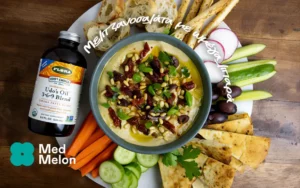Natural Sources of Flavonoids:
Fruits, vegetables, nuts, seeds, flowers, leaves, roots and bark.
Forms:
Standardized flavonoid extracts such as “Citrus Bioflavonoids”. Excellent ‘food’ sources of flavonoids include: green and black tea; grapes; berries; onions; and red wine. Excellent herbal sources include: ginkgo leaf extracts (ginkgo-flavone-glycosides); hawthorn berries, leaves and flowers; rosehips and burdock root tea.
Therapeutic Uses:
– Anti-aging
– Anti-inflammatory
– Antioxidant
– Brain Health
– Cataracts
– Cellular Regeneration
– Circulatory Disorders
– Cholesterol
– Cleansing/Detoxifying
– Eyesight Disorders
– Free Radical Related Diseases
– Immune System
– Lower LDL Cholesterol
– Sun Burn
– Vascular Disorders
– Wrinkles
Overview:
Flavonoids belong to a class of compounds known as polyphenolics that are widely distributed in the plant kingdom and are capable of protecting against several chronic and degenerative diseases, among them abnormal growths, vascular diseases, stroke, cataracts and brain and immune system disorders. These substances are common dietary components that have powerful antioxidant activity. For instance, tea contains several antioxidant flavonoids including catechins and quercetin, also concentrated in grapes, berries, onions and red wine. Italian research showed that drinking tea quickly increases the antioxidant activity in your blood by about 50 percent. Subjects drank slightly more than a cup of strong tea brewed for two minutes with three teaspoons of either black or green tea leaves. Tests revealed that antioxidant activity in the tea drinkers’ blood soared by 41 to 48 percent within thirty minutes after they drank the green tea and fifty minutes after they drank black tea (in both cases the activity decreased back to normal after 80 minutes). Flavonoids provide many health benefits through various mechanism of activity. Early studies of flavonoids investigated their significant antioxidant, antitumor, anti-inflammatory, anti-allergenic and liver protective effects. Additionally, their ability to modulate the activity of various enzymes that positively influence normal as well as malignant cells contributes to the beneficial effects of flavonoids in humans. Flavonoid extracts often incorporated into supplements and natural multivitamin products include: citrus bioflavonoids; quercetin; hesperidin; rutin; bilberries; blueberries; rosehips; ginkgo leaves; and tea. Rosa canina fruits are well known to contain a large amount of vitamin C, which is antioxidant. A recent study showed that the extract also contains many phenolics such as proanthocyanidins and flavonoids and that the antioxidative effects of Rosa canina are due not only to vitamin C but also to these polyphenolics. Burdock root is also an excellent source of antioxidant flavonoids.
Chemistry:
Flavonoids belong to a class of compounds known as polyphenolics that are widely distributed in the plant kingdom. Common flavonoids include catechin, epicatechin, myricetin, quercetin, and kaempferol. Other polyphenolic compounds, specifically phenolic acids, that are powerful antioxidants include: gallic acid, p-hydroxybenzoic acid, caffeic acid, ferulic acid, and ellagic acid. Anthocyanins and proanthocyanidins are also polyphenolic compounds considered by some to fall within the flavonoid category.
Suggested Amount:
The recommended daily dose of flavonoids ranges from between 300mg to over 1000mg daily, depending upon the source. Jean Carper, in her book Stop Aging Now, reports that one cup of green tea contains 375mg of catechins; a glass of red wine contains 300mg and a cup of black tea contains 210mg, based on tests by Dr. Andrew Waterhouse at the University of California at Davis. Hawthorn extracts are recommended with the dosage of 160-900 mg of a water-ethanol extract of the leaves or flowers (equivalent to 30-169 mg of epicatechin or 3.5-19.8 mg of flavonoids) administered in two or three doses. Ginkgo extracts are recommended with the dosage of 60-120mg/daily and the content of flavonoids in ginkgo leaf extracts range from 24-35.9%, depending upon the product. In one study, phenolic acids in blueberries and blackberries ranged from 0.2 to 259 mg/100 g fresh weight (FW), and flavonoids ranged from 2.5 to 388 mg/100 g FW. Total polyphenols ranged from 262 to 930 mg/100 g FW, and total anthocyanins ranged from 12.7 to 197.3 mg/100 g FW. In the above study, a linear relationship was observed between antioxidant activity and total polyphenols or total anthocyanins. The data indicate that blueberries and blackberries are rich sources of antioxidants. Note: See specific herbal monographs for more information
Drug Interactions:
None known.
Contraindications:
None known.
Side Effects:
None known.
References:
Daels-Rakotoarison DA, Gressier B, Trotin F, Brunet C, Luyckx M, Dine T, Bailleul F, Cazin M, Cazin JC. 2002. Effects of Rosa canina fruit extract on neutrophil respiratory burst. Phytother Res. 2002 Mar; 16(2): 157-61.
Horvathova K, Vachalkova A, Novotny L. 2001. Flavonoids as chemoprotective agents in civilization diseases. Neoplasma. 2001; 48(6): 435-41.
Rigelsky JM, Sweet BV. 2002. Hawthorn: pharmacology and therapeutic uses. Am J Health Syst Pharm 2002 Mar 1; 59(5): 417-22.
Sellappan S, Akoh CC, Krewer G. 2002. Phenolic compounds and antioxidant capacity of Georgia-grown blueberries and blackberries. J Agric Food Chem. 2002 Apr 10; 50(8): 2432-8.
Yang C, Xu YR, Yao WX. 2002. Extraction of pharmaceutical components from Ginkgo biloba leaves using supercritical carbon dioxide. J Agric Food Chem 2002 Feb 13; 50(4): 846-9
Additional Information:
None.




